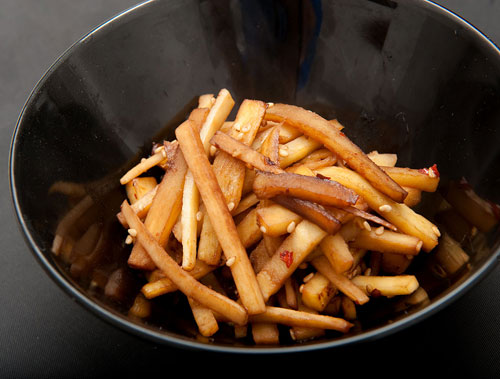Bento filler: Parsnip kinpira
When you don't live in Japan and you try to recreate Japanese recipes, ingredients can be a bit of a problem. I'm not really talking about the basic staples like soy sauce or mirin and so on; it used to be an issue trying to get a hold of those too, but with the growing popularity of Japanese cuisine in particular and Asian food in general, this has become much less of an issue. (Here, I either mailorder from stores in Paris or London, or stock up when we go to Lyon or Geneva.) But fresh ingredients are another matter. Take for example, the classic kinpira gobo, a terrific vegetable standby. It's crunchy, a bit spicy, and goes well in just about any rice based bento, conventional or otherwise. It's also very easy to make, freezes well, and is an all-around star. But getting hold of burdock (gobo) roots anywhere but a town with a sizeable Asian population? A bit difficult. Here in sleepy semi-rural France, forget it.
But I'm not complaining. I've already adapted the basic kinpira formula to use carrots only, or almost any kind of vegetable that's suitable. Here's yet another variation that uses a vegetable that you will not encounter in Japan, parsnips. I must admit I only encountered parsnip in the last decade or so of my life, after moving to Europe. I don't think they are that common in U.S. supermarkets nationwide either, unlike the ubiquitous carrot or broccoli. But they should be! They're naturally sweet, roast up beautifully, and make interesting purées or mashes. And, they have a crunchy fibrous texture that is quite similar to gobo.
So, here they are in kinpira form.

Because of their natural sweetness, no additional sugar or mirin is required, although you can add some if you like of course. A little bit of pre-treatment as it were is needed to counteract the texture, but it only adds a few minutes to your cooking time.
Recipe: Parsnip kinpira
Makes about 2 cups
- 2 medium to large parsnips, scrubbed well and peeled (you can skip the peeling if the skin is not so tough and bumpy)
- 1/2 cup water
- 1 tablespoon light cooking oil such as light olive oil or canola oil
- 1 tablespoon toasted dark sesame oil
- 1 tablespoon sesame seeds
- 1/8 teaspoon (or to taste) dried red chili pepper flakes, or use ichimi togarashi instead
- 2 tablespoons soy sauce
Cut the parsnips into thin matchsticks. This is a bit tough on your hands, especially if the parsnips have large cores, but it will be worth it!
(Note: You can skip this next step if your parsnips are young and tender and go straight to the stir fry step.) Heat up a large frying pan and put in the water. When the water is boiling, add the parsnips and put on a lid. Let it steam-cook for about 3 minutes. Open the lid and either drain off any remaining moisture or just let it evaporate.
Add the oils to the pan and stir fry the parsnips, 2-3 minutes. They should still be crisp but just about turning soft. Add the sesame seeds and chili pepper flakes and toss around well. Add the soy sauce and toss to coat everything well.
As with all kinpiras, this freezes very well. Just divide into individual portions and wrap in plastic, or use a freezer container. One way to make bento packing very convenient is to freeze kinpira in little divider cups; use disposable ones, or reusable silicone ones, whichever you have. To pack, just stick one in a bento, where it will defrost in plenty of time for lunch in most cases. (Although as with all kinpiras, in our household this rarely makes it to the freezer before it's all devoured.)
Kinpira pasta?
This is something The Guy came up with the other day, after I'd been experiementing with parsnip kinpira. Some of it didn't quite turn out right (I over- or under-did the parboiling part) but it still tasted good. He just boiled some linguine, added it and the kinpira to a pan and sautéed it a bit. It was spicy and crunchy and delicious. If you've made extra kinpira (any of the kinpira recipes on this site should work) give it a try!
If you enjoyed this article, please consider supporting this site by becoming my patron via Patreon.
